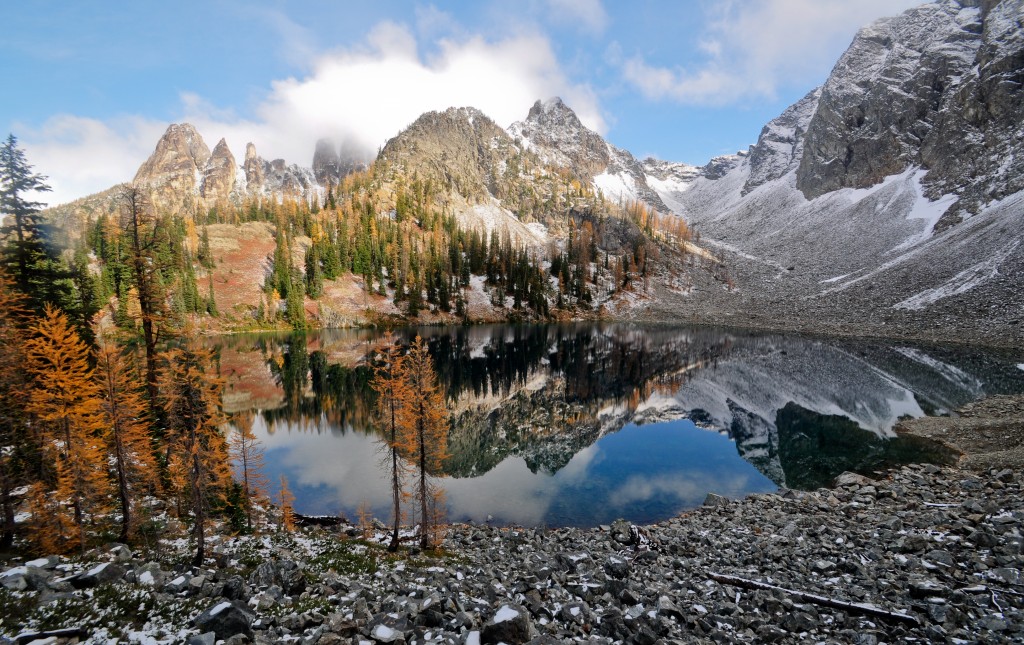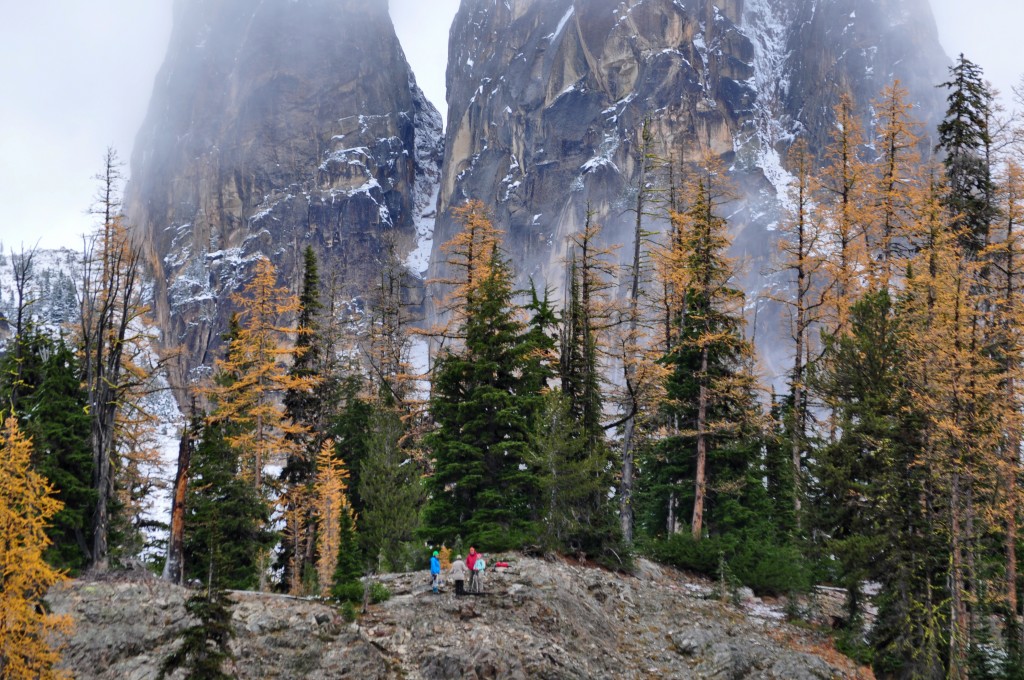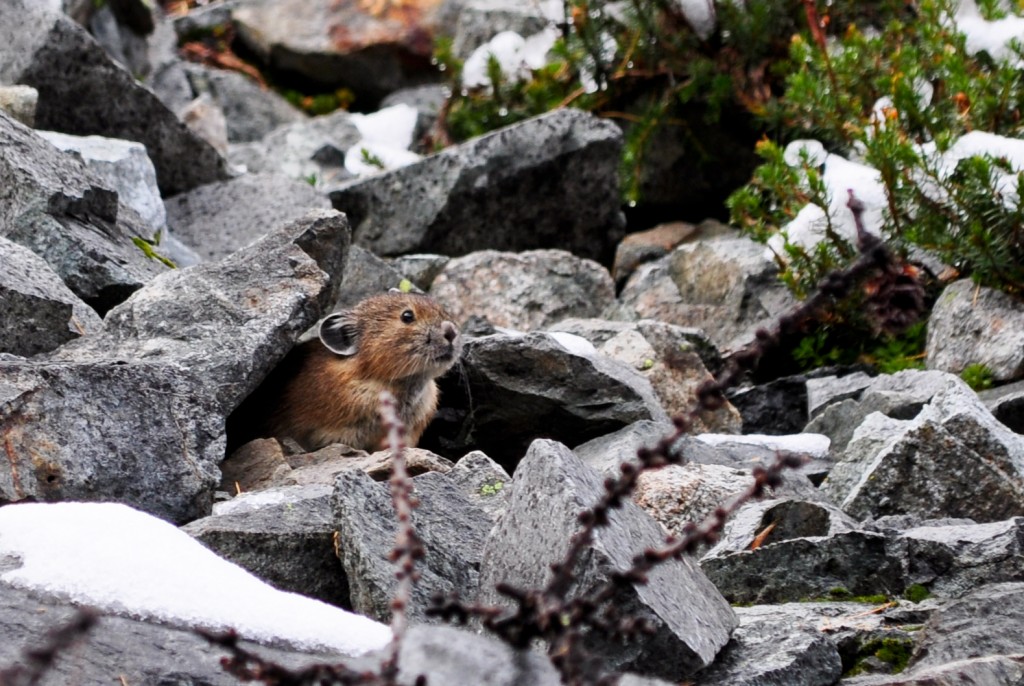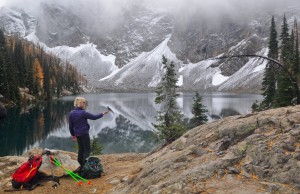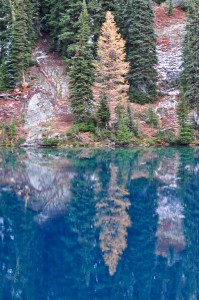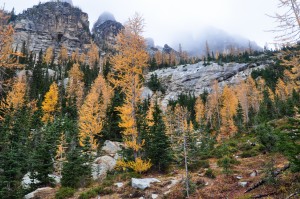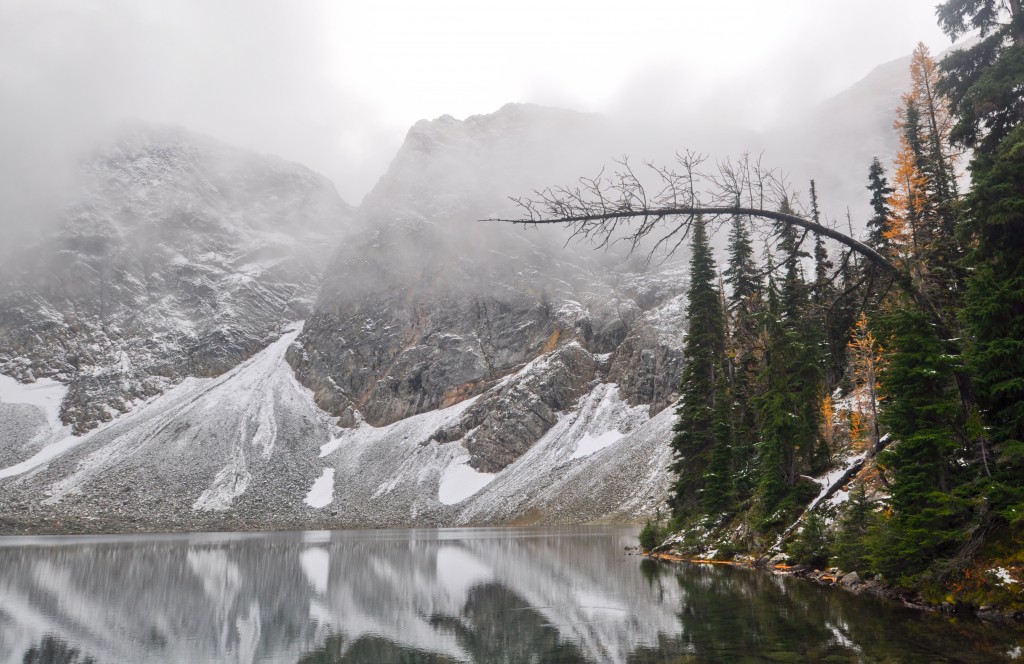The intermittent fog lifted to reveal a dramatic lake, worthy of a postcard.
Before me, aqua marine water was sitting in an alpine bowl sprinkled with a fairy dust of snow. Golden colored larches at the height of their transformation guarded the edges of the lake. In the background, spires lifted out of the landscape like mysterious karst landforms transplanted from southern China. A clatter of boulders hinted at native mountain goats, or perhaps just fall’s upheaval.
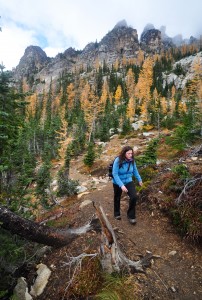 Blue Lake trail in the North Cascades is proof that you don’t have to hang up your hiking boots, just because summer is officially over.
Blue Lake trail in the North Cascades is proof that you don’t have to hang up your hiking boots, just because summer is officially over.
While October and November aren’t what you’d consider “optimal hiking months,” my recent outing reminded me why this time of year can be a fantastic experience.
Yes, the weather can be prickly. It’s especially unpredictable in the high country. But that’s part of what makes the season fun. Snow levels that come crashing down and rapid freeze/thaw cycles create interesting pockets of marvelous landscapes. They are places where seasons collide – especially if you’re lucky enough to find locations where frosty mountains meet brilliant autumn colors.
It is in these places, that I feel connected to the season and can sense the dramatic extremes that are especially profound at high altitude. These transition zones might be buried in snow one day, and basking under the sunny skies of a warm spell the next.
A Flurry of Life
Behind me, I heard the shrill call of a pika, a sharp “PEEP!”
You can’t help but laugh at the antics of these adorable critters. After all, pikas are the comic relief of the alpine. They scurry around rock falls and scree slopes filling their dens with grasses and seeds, while loudly defending their turf with squeeks that are all bark and no bite.
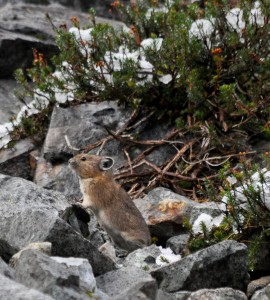 In the fall, you can feel their urgency – it won’t be long before they are buried under several feet of snow during the long winter months.
In the fall, you can feel their urgency – it won’t be long before they are buried under several feet of snow during the long winter months.
With their appearance, my attention is torn between the colossal landscape unfolding in front of me, and the fat little balls of cuteness darting behind me. I swing back and forth switching lenses to capture the ever-increasing blue sky with the wide angle, and the pikas with my zoom.
Gray Jays are also rather passionate about filling their bellies, and I trick them into landing on my hand by filling it with stones and pine needles. They don’t seem too awfully miffed (although they take several nibbles on my hand as if to say, “take that, jerk!”).
The Right Outlook
The right mindset and a spirit of adventure are important when you hike in transition zones. The weather can be unpredictable, so you may not get that perfect panorama you’re seeking. So finding cool little details when the weather turns is important.
It means embracing winter a little bit, and not fearing it. Unlike summer, there’s little guarantee that a particular hike will pan out. But you don’t have to worry about crowds, and you’re trading guarantees for a chance at something remarkable.
The day after my stunning hike at Blue Lake, Amanda and I attempted to reach a fire lookout on Goat Peak in the Methow Valley. But as the clouds rolled in, the whole hill became shrouded in mist. The sweeping views we wanted were reduced to 25-foot visibility.
Disappointing, yes. But we tried to enjoy the macro details instead. In our case, the joy we discovered came in the way fog swiftly rolled over a saddle in the trail and the pileated woodpecker who magically appeared out of the gloom just to disappear again, leaving only his hollow knocks to echo in the mist.
Finding the Right Hike
Most hiking guides will list particular trails as open through October, but that’s not to say you can’t stretch the season into November under the right conditions. But your timing has to be right. It requires a keen eye on the weather and above all else, good decision-making.
Which is why it’s hard to recommend a specific hike – by the time you read this, it could be covered in snow. So the hunt for a spectacular hike is part of the fun.
As the snow level drops, look for destinations just below this elevation. Using recent trail reports is highly advised. In our neck of the woods, I like to use the Washington Trails Association website (WTA.org) which has forums for hikers to post recent photos and conditions.
If you’re not an experienced outdoors person, I would definitely recommend hiking with someone who is. Keep your hikes short (if the weather turns, you can bail out quickly and follow your ascent trail).
Essentials for Fall Hiking
Hiking in the fall can be tricky and dangerous at times. Here are five essential tips according to the WTA
- Check the latest trail conditions – read how others have faired when choosing a hike to ensure the trail isn’t covered in snow. Contact the local ranger station for current conditions
- Let someone know where you are going – let them know your intended destination and when you plan to return
- Pack the essentials – topographic map, compass, extra food, extra clothing, a fire starter, matches, sun protection, a pocketknife, first-aid and a flashlight. An emergency shelter, hiking poles, ice axe and snowshoes are worth considering on fall hikes.
- Watch the weather forecast – conditions can change minute by minute. Don’t force a hike. If the conditions aren’t right, save it for another day.
- Beware of hunters – wear orange clothing and make noise while you hike if you are traveling in hunting zones.
A version of this post appeared in The Seattle Times on November 2, 2014
